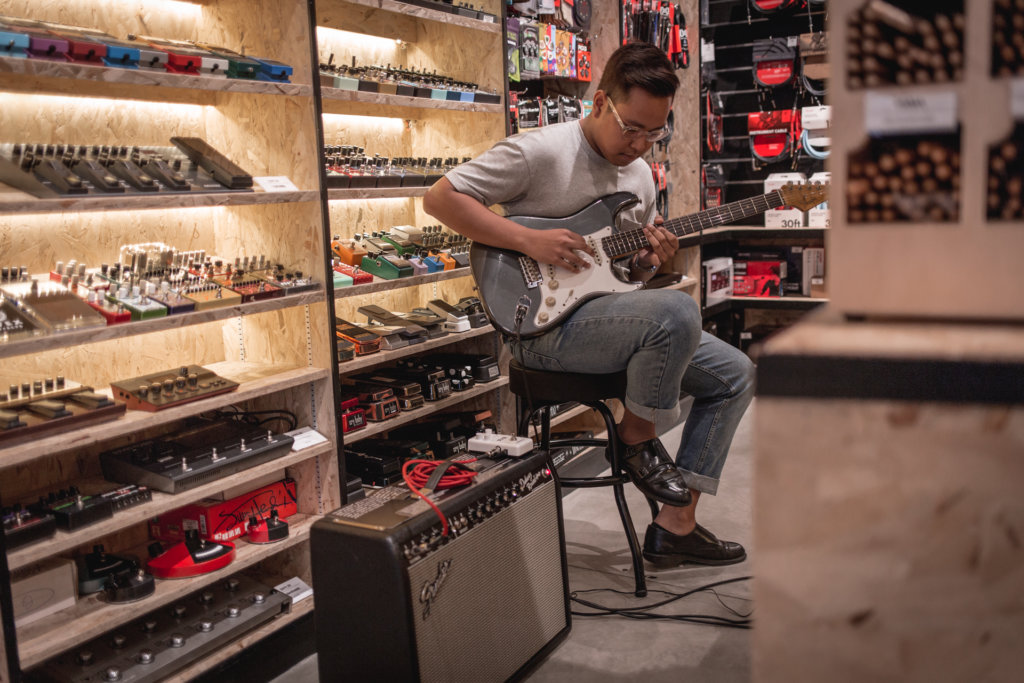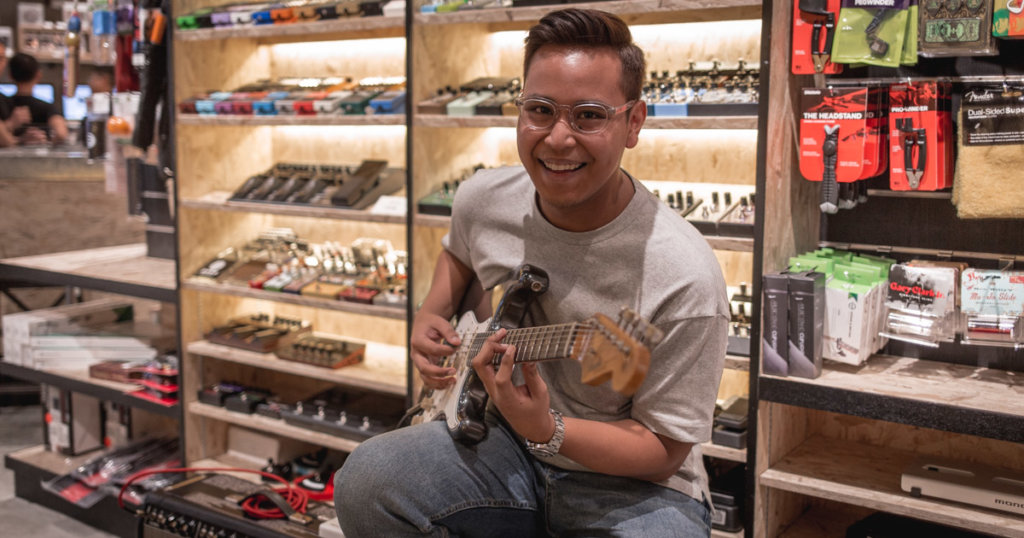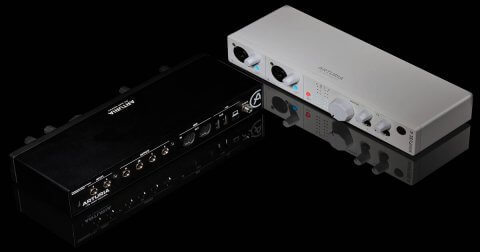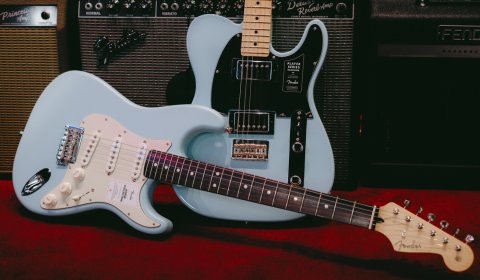Whether you’re new to pedalboard building or a long time pedal aficionado, the fact remains the same — trying to decide on your next pedal acquisition can quickly become overwhelming. The options never end and every permutation of your signal chain opens up new tonal possibilities.
A good way to help you make these crucial decisions is to observe how others build their boards. We put up-and-coming singer-songwriter Hasyir Ibrahim, known for his bluesy tones, to the test. We challenged him to build his ideal signal chain with $500, then $1,000, and finally to go all out with $2,000.

Signal Chain: Total under $500

TC Electronic Flashback Mini ($129), TC Electronic HOF Mini ($129)
Total: $476
This is a simple, compact pedalboard I would take to a small venue gig. As you can already tell, all of these pedals are mini versions of their OGs. Limiting size and weight is a plus when it comes to efficiency and portability, because lugging around a massive pedalboard to a small gig can be very uninspiring.
The TC Electronic Spark Mini does a great job of thickening your guitar’s tone, especially on a Strat. It also has a momentary switch which is very, very handy if I just want a boost for a split-second on a section of a song. I’d place it at the front of the chain so I can boost the signal into the overdrive next to it. This will blow your socks off.
Put a Tube Screamer into a Vita-Ray Chamber (shoutout Marvel Comics) and you get the Keeley Red Dirt Mini. It’s basically a Tube Screamer on steroids. The multiple dip switches allow for more tonal versatility which is perfect as I’m only rocking one overdrive for this pedalboard.
Lastly the TC Electronic HOF Mini. This is super important to me because sometimes when I show up to a gig, the PA or the amp provided doesn’t have a reverb unit. I prefer to play with reverb and besides, it’s a tiny pedal with one knob. Don’t let it fool you though — it’s fully customizable with TC’s TonePrint software.
Our recommended pedalboard: Koda ONE
Our recommended power supply: Voodoo Lab Pedal Power X4
Signal Chain: Under $1,000

Voodoo Lab Sparkle Drive Mod ($200), Teisco Delay ($189), TC Electronic HOF 2 ($179)
Jim Dunlop High Gain Volume Pedal ($129; not shown)
Total: $986
I play a lot of Blues/RnB music infused with ambient, long-decay, crazy reverb and I feel that these pedals can achieve this really well within the budget.
The Teisco Boost adds that really good ‘oomph’ to my guitar tone and is loaded with three different EQ settings. This pedal is one of the most versatile boost pedals out there. And the voltage doubler is just a plus! It can also double as a mild overdrive if dialled in properly.
TC Electronic’s Sub ‘N’ Up is crucial for those organ-like volume swells. This effect helps set the mood in a song, having more than just a single guitar tone, The sub and octave-up gives it an almost orchestral feel which I’m always chasing. Not to mention it also works really well before an overdrive and can end up sounding really aggressive.
Voodoo Lab’s Sparkle Drive Mod is a super cool pedal too. I’m able to get four different tones out of one pedal, saving pedalboard space and allowing me to quickly change my tone on the fly without having to worry about missing a beat. My favourite setting is Mod 1 as it punches out the bottom end and smoothes out the highs — great for those John Mayer lead tones.
TC Electronic’s HOF 2. What can I say? It’s not child’s play. I think it’s worth more than its price tag suggests. No seriously, you should try it out.
Our recommended pedalboard: MONO Pedalboard Small (Silver or Black)
Our recommended power supply: Strymon Ojai
Signal Chain: (a little over) $2,000

Keeley Katana Mini ($149), TC Electronic Sub ‘N’ Up Mini ($119), Fender Santa Ana ($299)
Bottom R-L: Teisco Fuzz ($170), TC Electronic Alter Ego 2 ($199), Strymon Big Sky ($649)
Dunlop High Gain Volume Pedal ($129; not shown)
Total: $2012
For this budget, I chose to include more pedals that tie down the overall tone of the guitar to make it nice and tight, but at the same time allow it to be dynamic.
I chose the Keeley Compressor Plus because of its dual setting switch that allows you to adjust the compressor’s attack and release for guitars with either humbuckers or single coil pickups. This gives you the best saturated tone you can get especially when paired with good overdrives. The next pedal in the chain for me, will always be the Keeley Katana Mini. This pedal, like the Red Dirt Mini, has multiple dip switches in them making it kinda the same as the bigger original Katana. The treble cut switch is a plus, taking off the screaming high end of a strat. For me, this pedal is always on with the boost switch engaged.
Fender’s Santa Ana Overdrive. This pedal gives me the chills everytime I hear it through a good sounding tube amp — the saturated lead tones are second to none. I like how there’s an option to use it as a boost pedal, bringing up the overall volume and not necessarily adding more gain. There’s also an option for true bypass and buffered. How bout that?!
The Teisco Fuzz is a really fun pedal. This silicon transistor fuzz easily cuts through the mix so I don’t have to worry if the audience can hear me. The coolest feature about this fuzz is its ability to switch between normal and octave mode, giving my guitar a bit more bite.
The Strymon Big Sky needs no introduction — it’s the holy grail. I know a lot of people will argue with me on this, but this pedal really satisfies my ambient needs. At times, I will just take this pedal and an overdrive like the Santa Ana to a simple gig. It’s that good (Strymon, please sponsor me ??).
Also, I know I went a little bit over budget, but the PolyTune is one of the best tuner pedals for performers. Quick and easy. I mean, if you’re already spending $2,000 on pedals, an extra $12 won’t hurt (unfortunately I only have 20 bucks right now)!
Our recommended pedalboard: MONO Pedalboard Medium (Silver or Black)
Our recommended power supply: Strymon Zuma
Pedalboards aside, tell us about the other gear you would use with these pedalboard setups

My main axe is a discontinued Fender John Mayer Signature Stratocaster in Olympic White. It’s my first ever proper guitar and I love it to death. A lot of people don’t really like the idea of having someone else’s name on their guitar but hey, “I only know New Light”.
The Big Dipper pickups are mid-scooped but really cuts through the mix when I hit a solo section. Lovely beast. Also, I run all my pedals into a modded Fender Blues Jr. III.
Check out Hasyir’s selection and the rest of our pedal collection here. There’s something for everyone and diving into the endless possibilities is part and parcel of the elusive search for tone.



